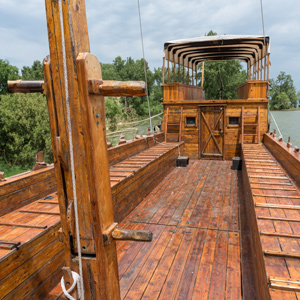Moving the flotilla of boats up the Missouri in the present states of South and North Dakota, the expedition encounters several nations with limited experience with St. Louis-based traders.
Soon after going around the Big Bend of the Missouri, they meet the Lakota Sioux, and a multi-day encounter goes badly for both peoples. They proceed on to some Arikara villages where they hold a council and invite Too Né (Eagle Feather) to travel with them. He provides useful information and would eventually visit Washington City.
In late October, they reach the Knife River Villages—a complex of Hidatsa and Mandan villages. With winter quickly approaching, they must act fast to establish winter quarters.
The Cheyennes
by Kristopher K. Townsend
Many, including the expedition members, misheard the people’s name as ‘chien’—French for ‘dog’. Their name actually comes from the Sioux exonym shahíyena, perhaps meaning ‘people of alien speech’. The captains thought that they might make good trading partners.
The Arikaras
by Kristopher K. Townsend
Spelled variously in the expedition journals, Clark sometimes called the Arikara people Pawnee due to their similar linguistic origins—both were Caddoan-speaking people. Weakened by smallpox and Sioux attacks, they would have significant impact on American fur trade interests on the Upper Missouri and affect the lives of several expedition members.
The Omahas
by Kristopher K. Townsend
The captains appeared eager to meet with the Omaha. They tried to find them at their two biggest villages and planted a flag at the gravesite of the chief who for many years had controlled trade in the region, the infamous Blackbird.
The Mandans
by Kristopher K. Townsend
After the 1781 smallpox epidemic, the Mandan had moved into to a more defensible position in two villages immediately south of the Hidatsa at the Knife River. The Mandan-Hidatsa alliance had developed many years prior, and the two tribes previously shared their large hunting territory to the west.
The Lakotas
by Kristopher K. Townsend
Presently known as the Lakota people, Lewis and Clark most often called them the Tetons. There were three main groups: Oglala, Brule, and Saone. The bands typically lived separately, hunted freely within each other’s territory, and came together for community events.
Hidatsa Territory
Becoming the Fort Berthold Reservation

After leaving Fort Mandan on 7 April 1805, the expedition traveled for several days through Hidatsa territory. Much of that area would become the Fort Berthold Reservation of the Three Affiliated Tribes, a coalition of Hidatsa, Mandan, and Arikara.
Synopsis Part 1
Washington City to Fort Mandan
by Harry W. Fritz
The Corps of Discovery, as it would be called, or the “corps of volunteers for North Western Discovery,” as Lewis put it, epitomized the rising glory of the United States—its sense of limitless possibilities and unparalleled opportunities.
The Barge
Barge, keelboat, or just 'the boat'?
by Joseph A. Mussulman
Meriwether Lewis listed a “Keeled Boat” in his pre-expedition shopping list, but after he finally got it, he and the other journalists of the Corps of Discovery simply called it “the boat” (190 times) or, less often, “the barge” (32 times).
Fort Randall Dam
Wolf tricks
by Joseph A. Mussulman
Here, Sergeant Gass went out with one of the hunters to retrieve the meat and hide of a buffalo the man killed the previous evening. The hunter had left his hat on the carcass “to keep off the vermin and beasts of prey,” apparently believing the scent of a human would scare them away”
The Big Bend of the Missouri
Around the 'Grand Detour'
by Joseph A. Mussulman
The huge meander called the Big Bend, or Grand Detour, had been a well-known Missouri River landmark for many years when the Corps of Discovery arrived at its lower bend on 19 September 1805.
Pierre by Air
Standoff
by Joseph A. Mussulman
Lewis and Clark first met the Teton Sioux on 25 September 1804. One of Jefferson’s primary political objectives for the expedition was to create a peace treaty and trade agreement them, the most potent military and economic force on the lower Missouri.
Lakota Sioux Difficulties
Tough times at the Bad
by James P. Ronda
Ignorant of plains politics, Lewis and Clark barely averted disaster in their encounter with Black Buffalo’s people—an article by James P. Ronda from a keynote address to the Lewis and Clark Trail Heritage Foundation, Pierre, South Dakota, August 2002.
Bad ‘humered’ Island
Change of heart
by Joseph A. Mussulman
On the evening of 25 September 1804 after a negative encounter with the Lakota Sioux, the Corps camped on a nearby island Clark called “bad humered Island.” The next morning, the Indians had a change of heart.
Fort Yates
Hunting party
by Joseph A. Mussulman
The Corps observed an Indian strategy for hunting game. As men on horseback herded pronghorns—”goats or Antelope,” Clark called them—into the river, boys swam among them and killed some with sticks, while others on shore shot them with bows and arrows.
Bismarck and Mandan
The main attraction
by Joseph A. Mussulman
The Corps of Discovery arrived in the vicinity on 20 October 1804, having worked their way some 1,450 miles up the Missouri in 155 days. That day, wildlife was the main attraction.
Experience the Lewis and Clark Trail
The Lewis and Clark Trail Experience—our sister site at lewisandclark.travel—connects the world to people and places on the Lewis and Clark Trail.
Discover More
- The Lewis and Clark Expedition: Day by Day by Gary E. Moulton (University of Nebraska Press, 2018). The story in prose, 14 May 1804–23 September 1806.
- The Lewis and Clark Journals: An American Epic of Discovery (abridged) by Gary E. Moulton (University of Nebraska Press, 2003). Selected journal excerpts, 14 May 1804–23 September 1806.
- The Lewis and Clark Journals. by Gary E. Moulton (University of Nebraska Press, 1983–2001). The complete story in 13 volumes.


